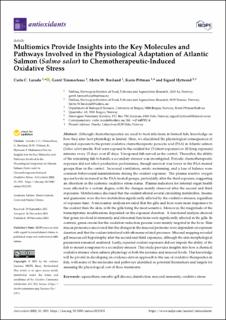| dc.description.abstract | Although chemotherapeutics are used to treat infections in farmed fish, knowledge on how they alter host physiology is limited. Here, we elucidated the physiological consequences of repeated exposure to the potent oxidative chemotherapeutic peracetic acid (PAA) in Atlantic salmon (Salmo salar) smolts. Fish were exposed to the oxidant for 15 (short exposure) or 30 (long exposure) minutes every 15 days over 45 days. Unexposed fish served as the control. Thereafter, the ability of the remaining fish to handle a secondary stressor was investigated. Periodic chemotherapeutic exposure did not affect production performance, though survival was lower in the PAA-treated groups than in the control. Increased ventilation, erratic swimming, and a loss of balance were common behavioural manifestations during the oxidant exposure. The plasma reactive oxygen species levels increased in the PAA-treated groups, particularly after the third exposure, suggesting an alteration in the systemic oxidative stress status. Plasma indicators for internal organ health were affected to a certain degree, with the changes mainly observed after the second and third exposures. Metabolomics disclosed that the oxidant altered several circulating metabolites. Inosine and guanosine were the two metabolites significantly affected by the oxidative stressor, regardless of exposure time. A microarray analysis revealed that the gills and liver were more responsive to the oxidant than the skin, with the gills being the most sensitive. Moreover, the magnitude of the transcriptomic modifications depended on the exposure duration. A functional analysis showed that genes involved in immunity and ribosomal functions were significantly affected in the gills. In contrast, genes crucial for the oxidation-reduction process were mainly targeted in the liver. Skin mucus proteomics uncovered that the changes in the mucosal proteome were dependent on exposure duration and that the oxidant interfered with ribosome-related processes. Mucosal mapping revealed gill mucous cell hypertrophy after the second and third exposures, although the skin morphological parameters remained unaltered. Lastly, repeated oxidant exposures did not impede the ability of the fish to mount a response to a secondary stressor. This study provides insights into how a chemical oxidative stressor alters salmon physiology at both the systemic and mucosal levels. This knowledge will be pivotal in developing an evidence-driven approach to the use of oxidative therapeutics in fish, with some of the molecules and pathways identified as potential biomarkers and targets for assessing the physiological cost of these treatments. | |
